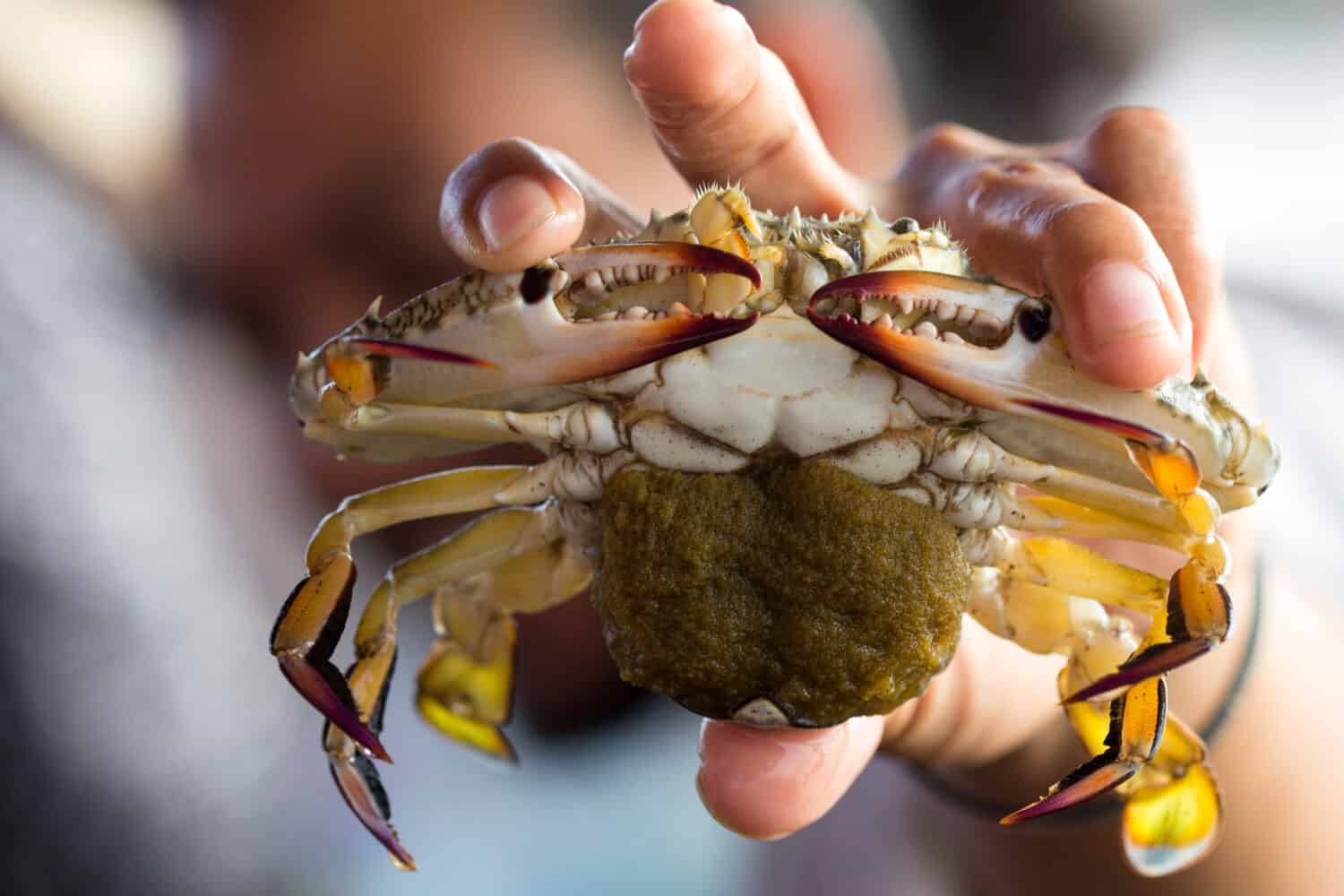New Jersey may be known for its beaches, boardwalks, and casinos, but what about its crabs?
Even though the Garden State has exceptional crabbing, Maryland, just a few hours’ drive away, is the state best known for this type of culinary treasure hunting.
Those famous Maryland crabs, however, are the same as the ones found in New Jersey’s shallow bays, rivers, and tidal creeks!
We’re talking about the bodacious blue crab.
If you’d like to try your hand at crabbing in New Jersey there are certain things you should know. They include what kind of trap to use, size limits, and one extremely important rule.

The sides of a collapsible crab trap open when sitting on the sandy bottom, and close when you pull up on the string.
©WoodysPhotos/Shutterstock.com
Beautiful Blues
The scientific name for blue crabs, Callinectes sapidus, translates to mean “beautiful savory swimmer.” One of the most valuable and sought-after shellfish, these crabs can be found all along the Atlantic Coast and the Gulf of Mexico.
And New Jersey lies in the heart of crab country!
Unless you’re a resident or regular visitor to the Jersey Shore, the hunt for blue crabs may still be one of its best-kept secrets. But along any dock, wharf, or backyard lagoon during the summer months, you’ll see folks of all ages trying to trap these savory swimmers.
And unless you are using certain kinds of traps, no license is required to do so.
Leave the ‘Crab Pots’ for Cooking
Catching blue crabs in New Jersey without a license requires the right kind of trap or line.
That includes a collapsible crab trap — one that is “open.” That means it’s escapable until you pull it up out of the water. The typical collapsible trap is a wire square, with four sides that open when placed on the sandy bottom. Pulling on the attached rope shuts the trap and contains the crabs.
You can also trap blue crabs with a hand line. This method uses twine or a fishing line typically baited with a piece of chicken that’s tied to the end. When a crab takes the bait, the line is slowly moved into reach and the crab is scooped up with a net.

If you’re crabbing with a hand line you’ll need a net to bring your crab in.
©Lena605/Shutterstock.com
Another kind of trap called a crab “pot” cannot be used without a shellfish license.
The crab pot is a square or oblong trap that once entered by a crab, is nearly impossible for it to escape from. Even with a license, a crab pot must have a biodegradable panel that will allow any trapped creatures to eventually escape should the trap become lost or abandoned.
Also not permitted without a license is the use of a “trotline.” That’s a long, anchored line containing multiple pieces of bait tied several inches apart.
Size Matters
New Jersey has very strict regulations when it comes to the size of the blue crabs you can keep. Most docks and fishing piers have signs that will remind you of the size of a keeper.
Crabs must be a minimum of 4.5 inches long, measured from point to point to take home. It’s always a good idea to bring along something to measure with.
As far as the number of crabs you can keep, the limit is one bushel a day. And that’s a lot! A bushel translates to approximately 75 crabs.
Crabs that don’t meet the size limit must be returned to the water immediately.
Respect the Eggs
One very important regulation you need to follow is not to keep females with eggs.
Female blue crabs carry their eggs in a sac called a “sponge” on the outside of their abdomen. “She crabs” can also be recognized by the red tips on their claws. The sponge can vary in color depending on how close to spawning it is, from yellowish orange to brown and black. A blue crab can spawn millions of eggs during its lifetime.
Females with a sponge must be safely returned to the water right away!
Keeping count of egg-bearing blue crabs in the water is so important to the state that the Department of Fish & Wildlife conducts an ongoing survey asking crabbers to report sightings via an online form.

A female blue crab carries her eggs in what’s called a “sponge” on her abdomen.
©SomprasongWittayanupakorn/Shutterstock.com
A Crab of Many Names
Blue crabs are also known by a variety of names.
Jimmies, for example, are adult males and sooks are adult females.
Females carrying eggs are known as sponge crabs. A crab that has just molted is known as a soft shell, and “peelers” are crabs about to molt. While a hard-shell blue crab must be 4.5 inches to keep, soft shells can be taken at 3.5 inches and peelers at 3 inches.
Where Does a Blue Crab Go in the Winter?
Perhaps one of the most interesting aspects of the New Jersey blue crab is its wintertime style of hibernation.
As the water temperature in New Jersey’s estuaries tends to be lower than that of Chesapeake Bay, Jersey blues behave differently in the winter than their Maryland counterparts.
Burying themselves partially in the sand, they go into a reduced metabolic state called torpor, which is considered unique to the state’s blue crabs. At around 50 degrees Fahrenheit (10 degrees Celsius) the crab will start its winter hibernation.
Although the New Jersey crabbing season is said to run from mid-March until the end of November, once the water temperature starts to drop, you won’t find many crabs crawling about.
That means the best time of year to throw out your traps is from mid-June to early October.
The photo featured at the top of this post is © P. Dorman/Shutterstock.com
Thank you for reading! Have some feedback for us? Contact the AZ Animals editorial team.







